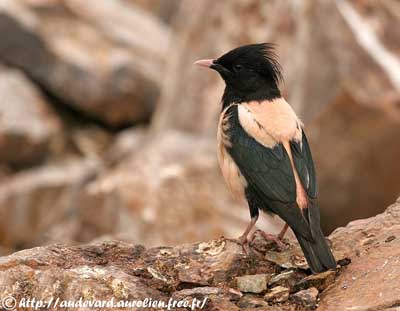
Rosy Starling
Sturnus (Pastor) roseus
Passeriforme Order – Sturnidae Family
BIOMETRICS:
Length: 21 cm
Weight: 60-88 g
DESCRIPTION:
The Rosy Starlings are used in China to eliminate the locusts which are considered crop pests. Artificial nests are built to attract the starlings, and today, the locusts’ populations are insufficient to feed the birds. That involves large decrease of insecticide use and a greatly successful plan.
Adult male in breeding plumage has black head, neck, throat and upper breast. The head shows elongated feathers on the nape, forming an erectile crest.
On the upperparts, back and rump are glossy pink. Wings are blackish-brown with glossy green secondaries. The uppertail is blackish-brown too, with green iridescence.
On the underparts, lower breast and belly are pale pink. The undertail-coverts are blacksih, as the thighs.
The bill is pink with black base in breeding plumage. The eyes are dark brown. Legs and feet are yellowish-brown.
Fr: Etourneau roselin
All : Rosenstar
Esp : Estornino Rosado
Ital: Storno roseo
Nd: Roze Spreeuw
Sd: Rosenstare
Photographers:
Aurélien Audevard
OUESSANT DIGISCOPING
Paul Guillet
Photos d'Oiseaux
Niraj V. Mistry
Photo Galleries
Ingo Waschkies
My bird pictures on Pbase
Text by Nicole Bouglouan
Sources:
HANDBOOK OF THE BIRDS OF THE WORLD Vol 14 by Josep del Hoyo-Andrew Elliot-David Christie - Lynx Edicions –
ISBN: 9788496553507
STARLINGS AND MYNAS, by Chris Feare and Adrian Craig. Christopher HELM - ISBN: 071353961X
BirdLife International (BirdLife International)
Wikipedia, the free encyclopaedia

In non-breeding plumage, the male has tipped-grey black feathers, tipped-brown pink feathers, brown-tipped undertail-coverts, and buff margins on flight feathers and wing coverts.
The bill is dark brown to blacksih in autumn and brownish-pink in winter.
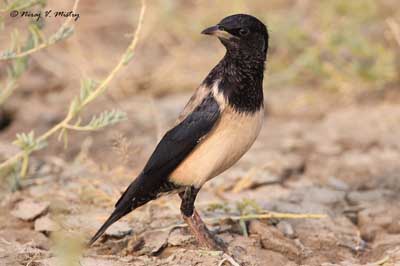

The female has similar plumage but slightly duller and she has shorter crest. In spring, she has mostly brown throat, nape and undertail-coverts with buffy feather tips.
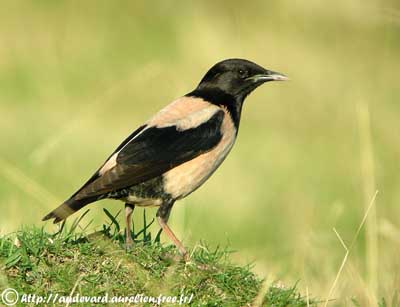
The juvenile has sandy grey-brown upperparts, paler rump with pinkish-buff wash, brown wings and tail with pale buff edges.
The underparts are pale buff, chin and throat are paler with slightly scaled pattern. The eye is surrounded by pale eye-ring. The bill is horn-coloured. Legs and feet are yellowish-brown.

The first winter has dull black head, short crest, back and underparts browner than adults and pale-tipped undertail-coverts.
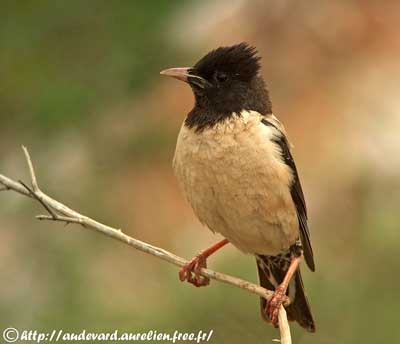
VOICE: SOUNDS BY XENO-CANTO
The Rosy Starling utters continuous contact chatter when feeding and roosting in flocks. It gives harsh and short alarm and flight calls, similar to those of the Common Starling.
The song is a series of warbling, whistled and grating phrases given from the ground during the courtship displays, while the female utters loud “tsili-tsili-tsili”.
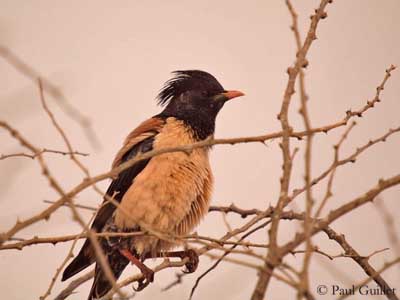
HABITAT:
The Rosy Starling frequents the open steppes during the breeding season, where it can find abundant Orthopterans. The colonies are often established near water and in valleys.
They move to more forested areas after breeding.
Outside this period, this species occurs in several types of habitats, as well wooded areas as open country.
They roost at night with other Sturnidae species in trees, thorny bushes and reedbeds, and often gather at daytime roosts near their feeding areas.
RANGE:
The Rosy Starling occurs from easternmost Europe, throughout temperate Southern Asia. It winters in India and tropical Asia.
This species is strongly migratory. The adults leave the breeding grounds before the juveniles. They travel in huge flocks.
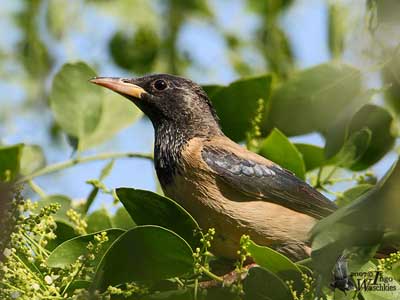
BEHAVIOUR:
The Rosy Starling feeds primarily on insects during the breeding season, and mainly locusts. It takes fruits in autumn. In winter, it consumes insects, fruits, seeds and nectar from flowers.
The locusts are caught on the ground. It forages usually in flocks and is highly gregarious all year round.
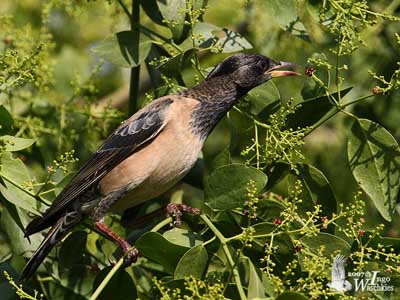
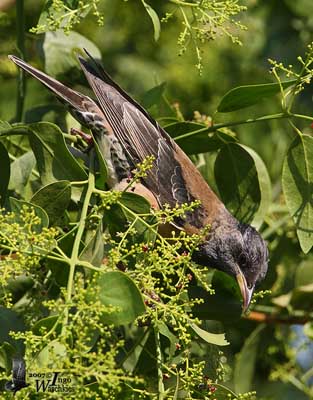
The Rosy Starling is monogamous and nests in huge colonies from hundreds to several thousands of birds. The season is short and closely associated to food resources.
FLIGHT:
The Rosy Starling has direct flight with rapid wing-beats and short glides. The large migrating flocks move as a single unit.
REPRODUCTION:
The Rosy Starling breeds between May and July.
The species breeds in huge colonies. The nest is often placed between stones or in crack in rock or cliff, in hole or crevice in building, in an old abandoned nest or even in tree hole.
The nest is built by both adults with grasses and twigs, and the cup is lined with finer grasses, feathers and sometimes aromatic plants.
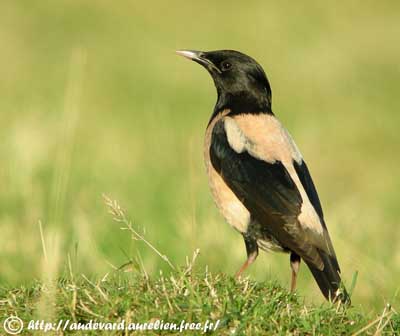
The female lays 3-6 pale blue eggs. Both sexes incubate, but mainly the female, during about two weeks. The chicks are fed by both parents and the nesting period lasts about three weeks. The juveniles still depend on adults for a short period after they leave the nest.
The colonies are preyed upon by avian and mammalian predators.
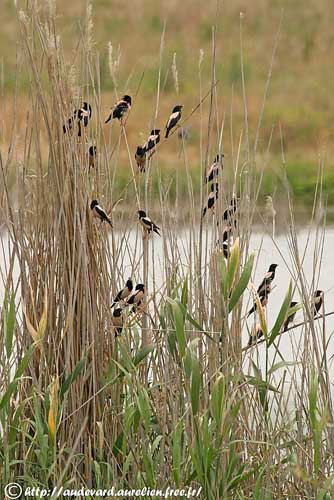
DIET:
The Rosy Starling feeds primarily on flightless locusts and other grasshoppers. It also takes bugs, ants, beetles, moths and caterpillars. Spiders, woodlice and snails are eaten too.
After the breeding season, it consumes fruits (wild and cultivated species), seeds of cereals and nectar from several flowers. It may follow cattle. It forages in flocks, sometimes very large ones.
PROTECTION/THREATS/ STATUS:
The Rosy Starling is common to abundant. It takes part in pest control by feeding on locusts, but it also damages fruit and cereal crops in post-breeding period.
The species is not currently threatened.